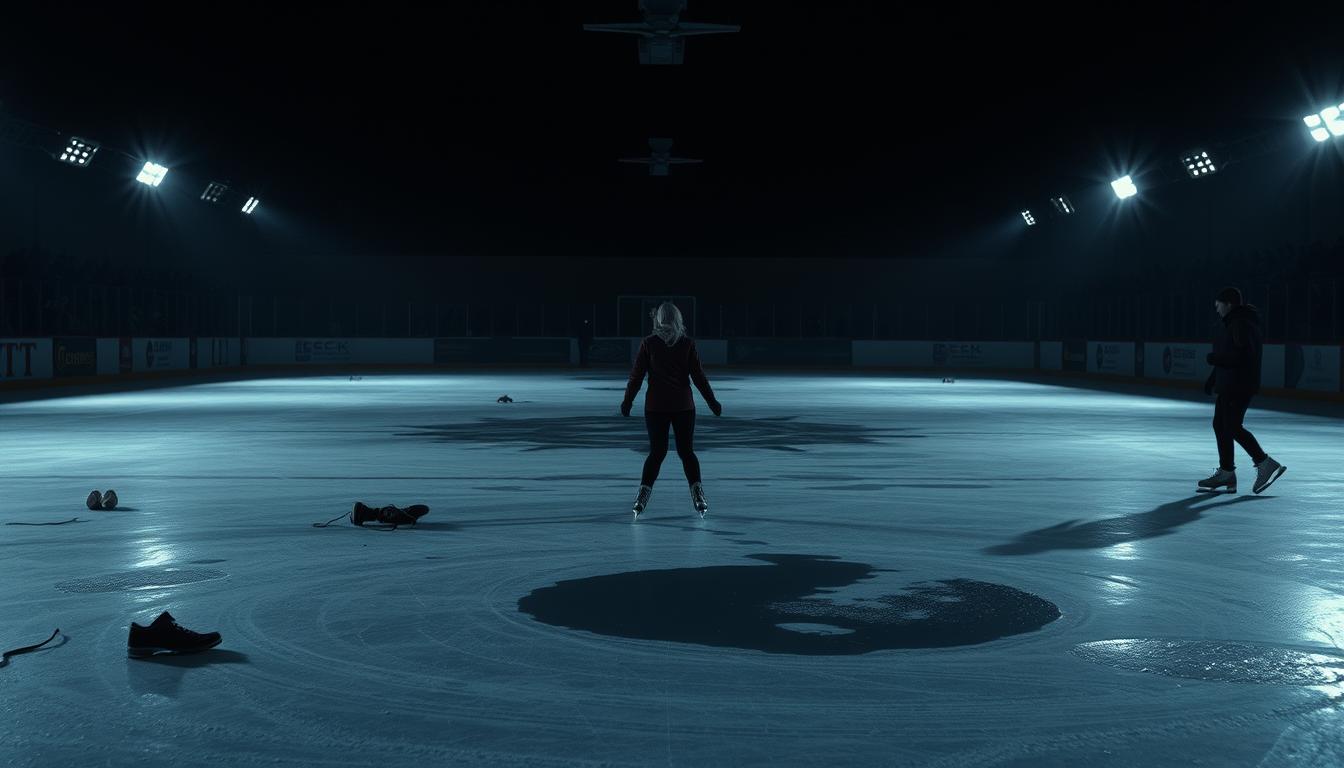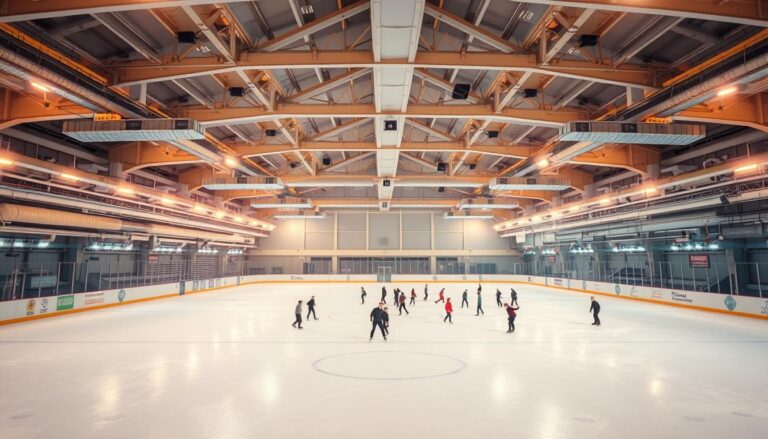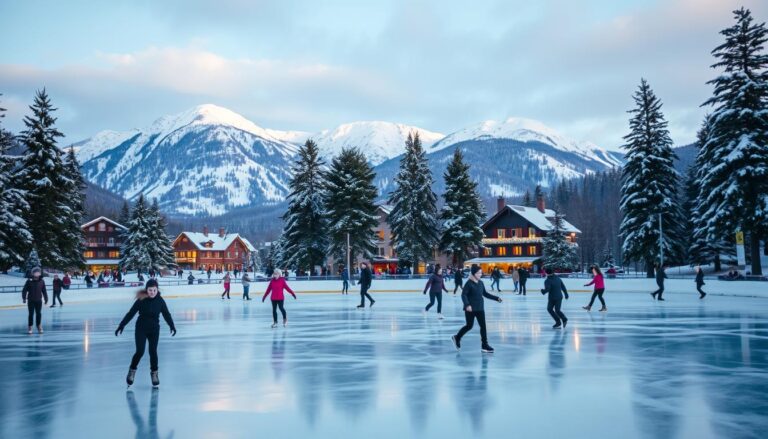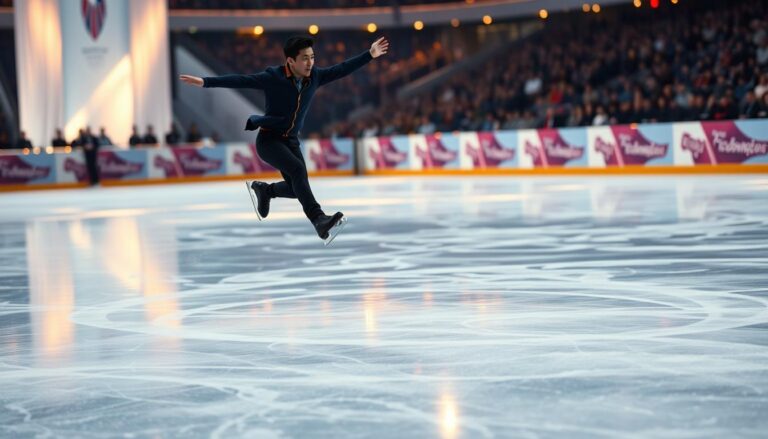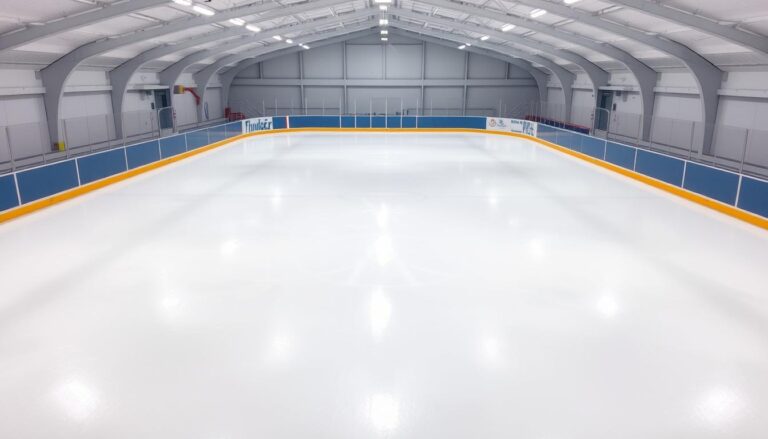Is Ice Skating Dangerous? What You Need to Know
Ice skating is more than a winter activity; it’s a thrilling mix of skill and risk. Many ask, “Is ice skating dangerous?” The answer is not a simple yes or no. Each time you skate, you balance technique, confidence, and preparation.
Both pros and hobbyists know ice skating comes with risks. But these can be managed with the right knowledge. Understanding the challenges and how to face them is key.
Ice skating is like riding a bike. There’s risk, but with the right training and gear, it becomes an amazing sport. The ice requires respect, balance, and smart moves.
Some stats show ice skating has physical challenges, but serious injuries are rare with safety steps. Beginners might feel scared, but learning the basics can lower risks a lot.
Learning about ice skating safety is your first step. We’ll cover what makes skaters confident: proper technique, protective gear, and smart ice decisions.
This guide will clear up ice skating’s dangers. It’s for both newbies and seasoned skaters wanting to stay safe. You’ll get tips to make your skating better and safer.
Ready to turn ice skating dangers into a fun, empowering activity? Let’s dive into the key info for skating with confidence and skill.
Understanding the Basics of Ice Skating Safety
Ice skating is a fun winter activity that mixes fitness, fun, and skill. Before hitting the ice, knowing safety tips is key for a great time. Getting ready right can make your ice time exciting and safe.
Different Types of Ice Skating Activities
Ice skating has many activities for all skill levels. Each one needs its own safety steps:
- Recreational Skating: Casual fun for beginners and families
- Figure Skating: Artistic with jumps and spins
- Speed Skating: Fast racing on long tracks
- Hockey Skating: Quick movements in a dynamic sport
Common Misconceptions About Ice Skating
Many think ice skating is scary. Let’s clear up some myths:
- Falling is part of learning
- Indoor rinks are safe with supervision
- You don’t need to be athletic to skate
Essential Safety Equipment
Protective gear is your ice skating best friend. Here’s a safety equipment guide:
| Equipment | Purpose | Recommended for |
|---|---|---|
| Helmet | Head protection | Beginners, children, advanced skaters |
| Wrist Guards | Prevent wrist injuries | All skill levels |
| Padded Shorts | Hip and tailbone protection | New learners |
| Well-fitted Skates | Ankle support and control | Everyone |
Knowing these basics prepares you for a safe and fun ice skating adventure. Remember, knowledge and preparation are your best safety tools!
Is Ice Skating Dangerous: Analyzing the Real Risks
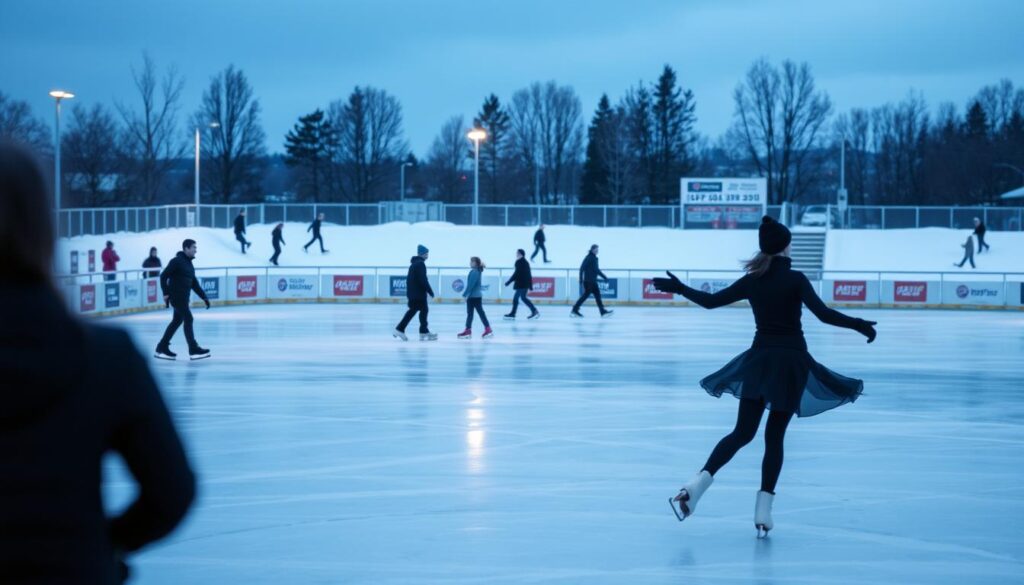
Ice skating risks are not as simple as they seem. While some think it’s dangerous, the truth is more detailed. Let’s dive into the safety side of this winter favorite.
By being well-prepared and using the right techniques, you can lower the risks. The main dangers include:
- Potential falls on hard ice surfaces
- Possible collisions with other skaters
- Risk of muscle strains or sprains
- Occasional blade-related injuries
Experts say the danger of ice skating depends on your skill and the environment. People who skate for fun usually get hurt less than those in sports like hockey or football.
| Skating Level | Injury Risk | Recommended Precautions |
|---|---|---|
| Beginner | High | Protective gear, lessons, supervised practice |
| Intermediate | Moderate | Continued skill development, balance training |
| Advanced | Low | Advanced technique, situational awareness |
Wearing good protective gear, taking lessons, and improving your skills can help a lot. Knowledge and preparation are your best defense on the ice.
Knowing the risks lets skaters enjoy the sport more. They can skate with confidence and strategy, making it a fun winter activity.
Statistical Overview of Ice Skating Accidents
Looking into ice skating injuries shows us a lot. The stats on ice skating accidents give us key insights. They help all skaters stay safer on the ice.
The world of ice skating injuries is complex. It changes a lot depending on where you skate. Researchers have found interesting patterns. These patterns help us understand risks and how to avoid them.
Age-Related Injury Patterns
Ice skating injuries vary by age:
- Children (5-12 years): More minor injuries
- Teenagers (13-19 years): More serious injuries from aggressive skating
- Adults (20-45 years): Often face serious muscle and joint injuries
- Seniors (45+ years): At higher risk for fractures and balance issues
Most Common Types of Injuries
Our study of ice skating injuries shows some interesting facts:
- Ankle Sprains: About 40% of all injuries
- Wrist Fractures: Common in beginners learning to fall
- Head Injuries: Less common but very serious
- Knee Ligament Strains: Often from sudden moves
Professional vs. Recreational Skating Incidents
There’s a big difference in injury rates between pros and amateurs. Pros get more specific injuries. Amateurs face more risks because they’re not as skilled.
Knowing these injury stats helps you stay safe. You can enjoy ice skating more confidently by understanding these risks.
Essential Protective Gear for Safe Ice Skating
When you start ice skating, keeping yourself safe is key. The right gear can make your skating fun and worry-free. Knowing what safety gear you need is the first step.
Here are the must-haves for staying safe on the ice:
- Helmet: Your first line of defense against head injuries
- Wrist guards to prevent fractures during falls
- Padded shorts for hip and tailbone protection
- Knee and elbow pads for extra impact protection
Choosing the right gear depends on how you skate and your skill level. Recreational skaters might need different gear than figure skaters or hockey players. Fit is key – bad fit can be worse than no protection.
Experts say get quality gear that’s flexible but strong. Brands like Triple Eight and 187 Killer Pads make gear for all skating types.
| Skating Type | Recommended Protection |
|---|---|
| Recreational Skating | Helmet, Wrist Guards, Knee Pads |
| Figure Skating | Lightweight Helmet, Padded Shorts |
| Ice Hockey | Full Protective Set: Helmet, Pads, Gloves |
Protective gear is not just for safety – it’s for confidence. When you feel safe, you’ll skate better and have more fun.
Proper Ice Skating Techniques to Prevent Injuries
Learning safe ice skating techniques is essential for fun on the rink. It’s about mastering movements that keep you safe. Balance, control, and the right body position are key.
Skating well means having core skills to avoid accidents. Start with understanding how your body works on ice.
Basic Stance and Balance
Your skating starts with a good stance. Focus on these basics:
- Keep knees slightly bent
- Center your weight over the middle of your skates
- Maintain an upright posture with shoulders relaxed
- Look forward, not down at your feet
Falling Safely on Ice
Falls are common. But you can reduce injury risk with the right techniques:
- Bend your knees to lower your center of gravity
- Keep arms loose and relaxed
- Avoid using hands to break a fall
- Roll to the side if possible to distribute impact
Stopping Techniques
Stopping safely is vital. Learn these methods:
| Technique | Difficulty Level | Best For |
|---|---|---|
| Snowplow Stop | Beginner | New skaters |
| Hockey Stop | Advanced | Experienced skaters |
| T-Stop | Intermediate | Developing control |
Practice these techniques in a controlled environment with proper supervision to build confidence and skill.
Environmental Factors Affecting Ice Skating Safety

The environment is key to your safety when ice skating. Skaters need to know about external factors that can affect their safety and experience.
Ice quality is a big concern for safety. Different surfaces can change how you skate and how safe you are.
- Indoor rink surfaces tend to be more consistent and controlled
- Outdoor natural ice presents unpredictable terrain variations
- Temperature fluctuations can create dangerous skating conditions
Before you skate, check a few important things:
| Environmental Factor | Potential Risk | Safety Recommendation |
|---|---|---|
| Ice Texture | Uneven surfaces | Inspect ice before skating |
| Rink Crowdedness | Collision risks | Maintain safe distance from other skaters |
| Lighting Conditions | Reduced visibility | Ensure adequate illumination |
Professional skaters know environment assessment is as important as skill. Knowing the risks helps you skate safely.
Weather affects outdoor skating a lot. Check the ice, temperature, and terrain before skating on natural ice.
- Check local weather reports
- Verify ice thickness with local authorities
- Wear appropriate protective gear
Knowing about these factors helps you skate safer and enjoy it more.
Health Benefits vs. Safety Concerns in Ice Skating
Ice skating is a mix of physical challenge and fun. Some ask, “Is ice skating dangerous?” But, the good parts often win when you’re careful.
Ice skating is more than a hobby. It’s packed with health benefits that change your body and mind.
Physical Benefits That Glide Beyond Expectations
- Full-body workout that burns up to 500 calories per hour
- Strengthens core muscles and improves overall balance
- Enhances cardiovascular endurance
- Develops lower body strength, mainly in legs and glutes
- Improves joint flexibility and coordination
Mental Health Advantages on Ice
Ice skating is not just for your body. Gliding on ice can be a great stress-reliever. It also boosts your mental health in big ways:
- Boosts mood and reduces anxiety
- Increases self-confidence and body awareness
- Provides a meditative and focused experience
- Creates chances for social interaction
Risk-Benefit Analysis: A Balanced Perspective
Safety concerns are real, but they can be lessened with the right steps. Beginners should take lessons, wear safety gear, and practice basics.
Understanding the risks is key. With the right mindset and safety steps, ice skating is fun and good for you at any age.
Safety Guidelines for Beginners on Ice
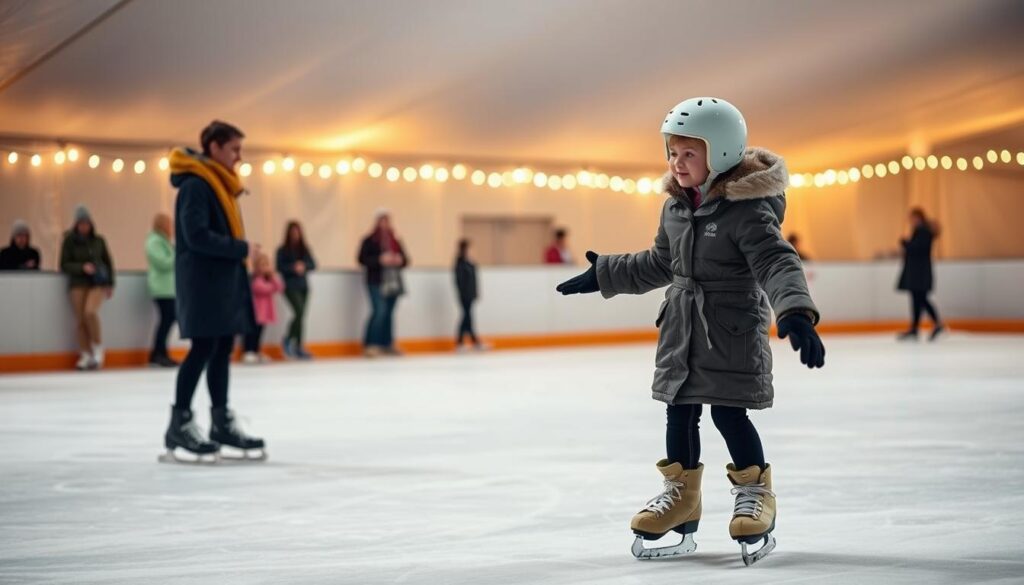
Stepping onto the ice for the first time can feel intimidating. But with the right safety tips, you’ll build confidence quickly. Learning how to ice skate safely is key for enjoying this exhilarating winter sport.
Before hitting the rink, preparation is key. Your first priority should be selecting the right equipment and understanding basic safety protocols.
- Wear properly fitted ice skates with good ankle support
- Always use protective gear like helmets and wrist guards
- Take beginner lessons from a qualified instructor
- Start in designated learning areas of the rink
Mastering balance and control is fundamental to skating safely. Beginners should focus on developing a stable stance. Learning essential techniques for maintaining equilibrium on the ice is also important.
| Safety Tip | Importance |
|---|---|
| Proper Stance | Reduces fall risk by 60% |
| Protective Gear | Minimizes injury severity |
| Controlled Movement | Increases skating confidence |
Remember, progress takes time. Don’t rush your learning process. Practice fundamental skills like stopping, turning, and falling safely. This will build a solid foundation for your ice skating journey.
Professional Training and Supervision Importance
Learning to ice skate safely is more than just watching videos. Professional training turns beginners into skilled skaters. It offers structured guidance and personalized lessons.
Certified instructors are key in teaching ice skating safety. They teach skaters the basics and help them avoid injuries. They use expert techniques and hands-on coaching.
- Learn correct body positioning and balance
- Receive immediate technique corrections
- Understand safety protocols specific to ice skating
- Build confidence through professional guidance
Group lessons are great for beginners. Structured environments let skaters learn with others. This creates a supportive and motivating space. Instructors can quickly spot and help with individual challenges.
For advanced skaters, private coaching is vital. One-on-one sessions focus on complex techniques and specific goals. Professional supervision ensures safe and efficient progress.
Professional training offers many benefits:
- Reduced injury risk
- Accelerated skill progression
- Comprehensive safety education
- Personalized feedback
Whether you’re new or experienced, professional training is essential. It helps you master ice skating safely and confidently.
Ice Rink Safety Standards and Regulations
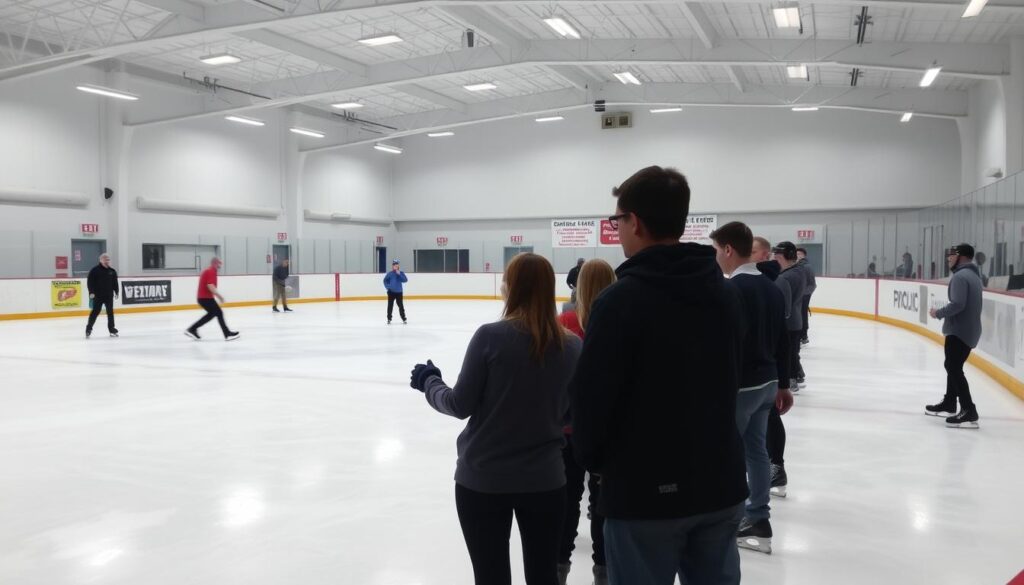
Safety is key for a fun ice skating time. Professional rinks follow strict rules to keep skaters safe. Knowing these rules helps you choose the right place and way to skate.
Ice skating safety starts with clear rules for every part of the rink. These rules cover how the ice is made and kept safe. They make sure everyone can skate safely.
Indoor Skating Safety Protocols
Indoor rinks need special safety steps to keep skaters safe. Important tips for skating indoors include:
- Keeping the ice at 24-26 degrees Fahrenheit
- Checking the ice often and keeping it in good shape
- Marking where to skate and what skill level is needed
- Checking safety gear is in order
Outdoor Skating Safety Considerations
Outdoor skating has its own set of challenges. Skaters need to watch out for the ice and the weather.
Important things to think about for outdoor skating are:
- Checking how thick the ice is
- Watching the weather
- Knowing where it’s safe to skate
- Having emergency help ready
Maintenance Requirements
Keeping the rink in good shape is vital to avoid accidents. Professional places clean and fix the ice regularly to keep it perfect for skating.
Important maintenance steps are:
- Resurfacing the ice every day
- Checking equipment often
- Keeping moisture and temperature right
- Fixing any ice problems right away
Knowing these safety rules helps skaters have a safe and fun time. Always put safety first and follow the guidelines when skating.
Emergency Response and First Aid for Ice Skating Incidents
When ice skating injuries happen, acting fast and right can greatly help in recovery. Knowing basic first aid for ice skating accidents is key. It helps you handle unexpected situations on the ice.
Ice skating injuries can be from small bumps to serious fractures. It’s important to know how serious an injury is for the right care. Both pro skaters and fun skaters should be ready for accidents.
Immediate Response Steps
- Assess the injured skater’s condition carefully
- Keep the person warm and prevent shock
- Check for signs of serious injury
- Call emergency services if needed
Most ice skating injuries can be handled with the right first aid. Staying calm and knowing basic emergency steps can stop things from getting worse.
Common First Aid Techniques
- For cuts and bruises:
- Clean the wound with antiseptic
- Apply cold compress
- Use sterile bandages
- For sprains:
- Apply RICE method (Rest, Ice, Compression, Elevation)
- Immobilize the affected area
- Seek medical attention if pain persists
Knowing emergency steps can lower the risk of long-term injury. Always carry a first aid kit when ice skating.
Prevention is always better than cure. Training, awareness, and safety gear can lower the chance of serious injuries.
Special Safety Considerations for Children and Seniors
Ice skating is fun for all, but safety matters more for kids and seniors. Knowing the right safety steps helps both groups skate safely and with confidence.
For kids, safety starts with watching them closely and making sure they wear the right gear. Young skaters need help to learn and stay safe.
- Choose correctly sized skates with ankle support
- Use protective gear like helmets and padded clothing
- Enroll in professional skating lessons
- Practice on beginner-friendly rinks
Seniors have their own safety needs for ice skating. It’s important for them to stay balanced and know their limits.
- Select skates with enhanced stability
- Warm up thoroughly before skating
- Use walking aids or support bars when needed
- Skate during less crowded rink times
Always check with doctors before starting any new activity, like ice skating, for kids and seniors.
By following these safety tips, kids and seniors can have a great time on the ice. They can enjoy winter without worrying about safety.
Conclusion
Ice skating can be safe if you prepare well. People of all skill levels can enjoy it by following safety rules, wearing the right gear, and learning basic moves.
Ice skating is more than just safety. It’s a way to stay fit, build mental strength, and have fun. Whether you’re at a local rink or a big arena, it combines exercise with creativity.
Knowing how to skate is key to staying safe. Learning the right techniques, knowing the ice conditions, and staying within your abilities helps avoid injuries. This way, you can enjoy the sport more.
Are you ready to try ice skating? Start with confidence, get ready, and always put safety first. No matter your skill level, you’re on the path to learning and enjoying this exciting sport.
